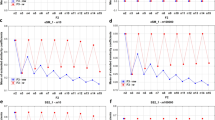Summary
A method for assessing the biological discriminating power of chemical similarity measures is presented. The main concern of this work was to develop an objective way of evaluating different similarity measures in terms of how well they distinguished between active and inactive compounds. In addition, we have explored the level of similarity required for optimal separation and commented on its implications for work in the field of chemical diversity studies. The results for one simple similarity measure showed that statistically significant separation could be achieved, and indicated a reasonable similarity value for future work.
Similar content being viewed by others
References
Brown, R.D., Bures, M.G. and Martin, Y.C.,A comparison of some commercially available structural descriptors and clustering algorithms, In Barach, S.M. (Ed.) Proceedings of the First Electronic Computational Chemistry Conference -CDROM, ARInternet, Landover, MD, 1995.
Concise Oxford English Dictionary, Oxford University Press, Oxford, U.K., 1981.
Rouvray, D.H., In Johnson, M.A. and Maggiora, G.M. (Eds.) Concepts and Applications of Molecular Similarity, Wiley, New York, NY, 1990, pp. 15–42.
Willett, P. and Winterman, V.,A comparison of some measures for the determination of intermolecular structural similarity, Quant. Struct.-Act. Relatsh., 5 (1986) 18–25.
Daylight Chemical Information Systems, Manual to v434, Santa Fe, NM, 1994.
Anderberg, M.R., Cluster Analysis for Applications, Academic Press, New York, NY, 1973, p. 89.
Davies, O.L. and Goldsmith, P.L., Statistical Methods in Research and Production, Oliver and Boyd, Edinburgh, U.K., 1972, p. 78.
Hall, L.H., Hall Associates Consulting, Professor of Chemistry, Eastern Nazarene College, Quincy, MA.
Tripos Associates Inc., St. Louis, MO.
Martin, E.J., Blaney, J.M., Siani, M.A., Spellmeyer, D.C., Wong, A.K. and Moos, W.H.,Measuring diversity: Experimental design of combinatorial libraries for drug discovery, J. Med. Chem., 38 (1995) 1431–1436.
Taylor, R.,Simulation analysis of experimental design strategies for screening random compounds as potential new drugs and agrochemicals, J. Chem. Inf. Comput. Sci., 35 (1995) 59–67.
Author information
Authors and Affiliations
Rights and permissions
About this article
Cite this article
Delaney, J.S. Assessing the ability of chemical similarity measures to discriminate between active and inactive compounds. Mol Divers 1, 217–222 (1996). https://doi.org/10.1007/BF01715525
Received:
Accepted:
Issue Date:
DOI: https://doi.org/10.1007/BF01715525




